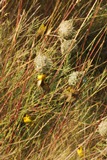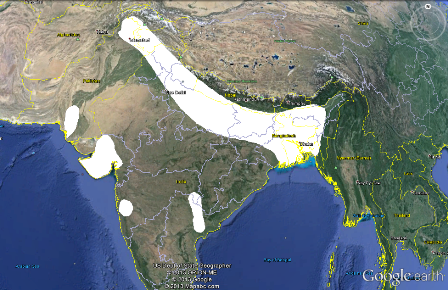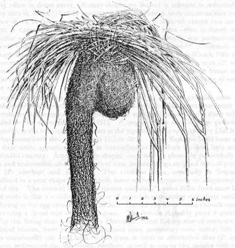Weaver species
Choose different species from drop-down list and press 'Go' button. See Full species list.Black-throated Weaver Ploceus benghalensis
IUCN: Least concern Discovery: 002Categories: Asian, long tube, white eggs, acacias, Linnaeus,
News items about species
Discovery
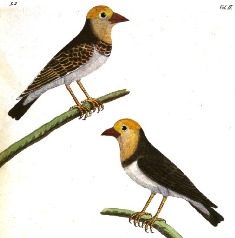
figure from Albin 1738 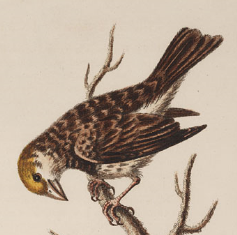
figure from Edwards 1751 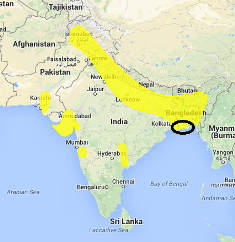
type locality circled IntroductionLinnaeus based his species description on the publications of Eleazar Albin and George Edwards. Both Albin and Edwards based their illustrations of this species on birds in the collection of Mr Joseph Dandridge, an English entomologist.Albin, an English naturalist and water-colour illustrator, included a short text and copper plate engraving illustrations in his book "A natural history of birds", and Vol 2 contained the Black-throated Weaver. Albin listed the two birds as a pair but they actually represent males, although they are poor illustrations. Albin called the birds Passer bengalensis (Bengale Sparrow), and Linnaeus used this name, although placing the bird in the genus Loxia. Edwards published his own version of the birds 13 years later, and provided a metal engraving which was a more accurate illustration of the species, indicating that he probably saw the Dandridge collection. Edwards called it the Yellow-headed Indian Sparrow. Scientific citationLoxia benghalensis Linnaeus 1758 Syst. Nat., ed. 10, p175 BenghalaMeaning of namesbenghalensis (Latin) - After the states of East (Bangladesh) and West Bengal, India. Historically Bengal (native name Bangala) comprised the greater part of northern India.First English nameBengal Sparrow [Cock and hen sparrows from Bengal] (Albin 1738).Alternate namesBlack-breasted Weaver, Bengal WeaverCollectorUnknown, sent to Mr Joseph Dandridge in England.Date collectedBefore 1738, when Albin published his painting.Locality collectedBengal, or Bay of Bengal.Type specimensNo type specimens known to survive, but the paintings of Albin and Edwards serve as types. |
The above is based on Weaver Wednesday 2, a weekly series about the discovery of each weaver species.
This species text first appeared as
Weaver Wednesday [119] - Discovery [2]: Black-throated Weaver on 2014-09-24
1. Basic biology
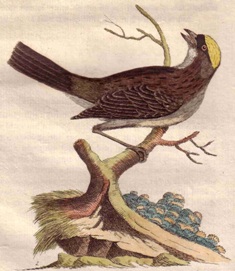
figure from Latham 1783 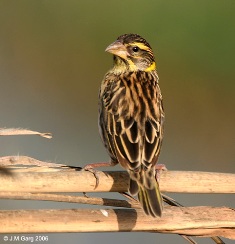
figure from wikipedia
Distribution. The Black-throated Weaver occurs in eastern Pakistan (in the Indus floodplain), northern India (mainly in the Ganges floodplain from Punjab east to West Bengal and Assam) and southern Nepal to Bangladesh. There are also scattered records in peninsular India (see map below, based on Handbook of the Birds of the World, Vol. 15). No subspecies are recognised. Habitat. The Black-throated Weaver inhabits lowland grassy areas near water, with tall standing grass and reeds, especially in areas with periodic flooding. Food.
The Black-throated Weaver feeds mainly on seeds, including those of grasses, rice, wheat, millet and sorghum. Nestlings are fed mainly with insects, especially grasshoppers, and also caterpillars, beetles, spiders, and small snails. This species is gregarious, foraging in flocks, and often foraging and roosting with other species.
Breeding. The Black-throated Weaver is polygynous. It nests singly or in scattered colonies of 4 or 5 nests, and sometimes in larger colonies. The male courts females with quivering wings, and bows downwards to expose the yellow crown. The nest is retort-shaped with an entrance tunnel of 6-30 cm length. The nest is woven by the male from strips of grass or reed blades. It is suspended 1-2 m above the ground from grasses or attached to reeds or bulrushes, and rarely in trees. At an early stage of building (the "helmet" stage), the inner rim is plastered with cow dung or human faeces, and bright yellow flowers. If a female accepts a nest structure, it is then completed, and no further decorations are added. A male may have up to 4 nests at one time. The clutch is usually 3 eggs which are white and unmarked. The female incubates and feeds the chicks, with the male contributing food during the final five days. Nests may be destroyed by grazing cattle, and by people harvesting reeds. Intraspecific brood parasitism probably occurs as clutches of around 6 eggs have been found. Deserted nests may be used for roosting and breeding by the Indian Silverbill Euodice malabarica, and also by the long-tailed tree mouse Vandeleuria oleracea. |
The above is based on Weaver Wednesday, a weekly series about weaver species.
This species text first appeared as
Weaver Wednesday [84]: Black-throated Weaver on 2014-01-22
2. Breeding facts
| Pair bond Polygynous Breeding season Jun-Oct in India Nest site suspended 1-2 m above ground from Pennisetum or Saccharum grasses (with upper dome directly attached to grass) or attached to reeds or bulrushes (Typha), at one site to Zizyphus plants, and in Acacia tortilis plantation only in clearings and not where canopy dense Nest building woven by male Colony size Colonial Clutch size usually 3 eggs (mean of 110 clutches) Egg colour white, unmarked Egg size average size of 100 eggs 20.3 x 15 mm Incubation incubation by female, period 13-15 days Chicks and nestling period chicks fed with insects by female, male contributing during final five days, nestling period 15 days |
Breeding information based on Handbook of the Birds of the World, Vol. 15.
3. Photos of Weaver Nests
No records yet - be the first to submit a PHOWN record!See PHOWN summary page for this species here.
PHOWN (Photos of Weaver Nests) provides valuable info on breeding distribution and colony sizes of weavers.
You can contribute by registering and submitting photos at Virtual Museum webpage.
4. Breeding distribution
Google map showing distribution (For species with small ranges you need to zoom in at the correct area to see the range):
yellow blob - range of weaver species; read more about this here.
![]() - PHOWN records with photos
- PHOWN records with photos
![]() - PHOWN records with no photos (Nest Record Cards, other records)
- PHOWN records with no photos (Nest Record Cards, other records)
![]() - Birdpix records
- Birdpix records
![]() - comments on out of range records, or interesting records
- comments on out of range records, or interesting records
![]() - type locality
- type locality
CLICK on the marker on the map to see individual record details.
5. Range changes
Not South African speciesThe above is based on Weaver Wednesday 3, a weekly series about range changes in South African weaver species.
This species text first appeared as
n/a








